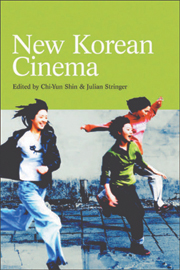Book contents
- Frontmatter
- Contents
- Notes on the Contributors
- List of Illustrations
- Introduction
- Part I Forging a New Cinema
- Part II Generic Transformations
- Part III Social Change and Civil Society
- 11 Peppermint Candy: The Will Not to Forget
- 12 The Awkward Traveller in Turning Gate
- 13 Memento Mori and Other Ghostly Sexualities
- 14 Interethnic Romance and Political Reconciliation in Asako in Ruby Shoes
- Glossary of Key Terms
- Bibliography of Works on Korean Cinema
- Websites
- Index
13 - Memento Mori and Other Ghostly Sexualities
from Part III - Social Change and Civil Society
Published online by Cambridge University Press: 05 August 2013
- Frontmatter
- Contents
- Notes on the Contributors
- List of Illustrations
- Introduction
- Part I Forging a New Cinema
- Part II Generic Transformations
- Part III Social Change and Civil Society
- 11 Peppermint Candy: The Will Not to Forget
- 12 The Awkward Traveller in Turning Gate
- 13 Memento Mori and Other Ghostly Sexualities
- 14 Interethnic Romance and Political Reconciliation in Asako in Ruby Shoes
- Glossary of Key Terms
- Bibliography of Works on Korean Cinema
- Websites
- Index
Summary
In an English-language anthology dedicated to the ‘new’ South Korean cinema, where issues of Western cultural imperialism and neo-colonialism will inevitably raise their heads, we encounter special difficulties as we address themes of alternative sexuality. Even if basic civil rights ideology derived from much-dreaded ‘Western cultural imperialism’ has recently swollen the ranks of Seoul's gay-pride ‘Mujigae Parade’, South Korea has yet widely to disseminate queerly contentious media, let alone foster something like a Westernised queer film movement. Therefore, when we consider Korea's few extant queer films, we are caught between condescendingly excusing the absence of a progressive queer theory in Korea, and engaging transnational or universalised readings that, with equal condescension, pretend Korean homosexual identities are not historically particular. But Korean sexual culture diverges not only from Western sexuality, but also from other East Asian sexualities.
While, in China, the records of the Han Dynasty glorified male homosexuality among the aristocracy, and while Japanese literature, from Murasaki Shikibu's The Tale of Genji to Saikaku's Life of a Sensuous Man, has traditionally included bisexuality as a regular facet of upper-class hedonism, Korea has no classical or canonised literature of same-sex love. True, it is well known that, in the Silla Kingdom (57 bc–ad 935), the Hwarang, a military troop of handsome, aristocratic youths, made homosexual love (and occasional transvestism) a part of their martial ethos, and that, during the Koryǒ Dynasty (935–1392), homosexuality was tolerated among aristocrats and Buddhist monks.
- Type
- Chapter
- Information
- New Korean Cinema , pp. 180 - 192Publisher: Edinburgh University PressPrint publication year: 2005



